ArcSegment Class
Definition
Important
Some information relates to prerelease product that may be substantially modified before it’s released. Microsoft makes no warranties, express or implied, with respect to the information provided here.
Represents an elliptical arc between two points.
public ref class ArcSegment sealed : System::Windows::Media::PathSegmentpublic sealed class ArcSegment : System.Windows.Media.PathSegmenttype ArcSegment = class
inherit PathSegmentPublic NotInheritable Class ArcSegment
Inherits PathSegment- Inheritance
Remarks
Use a PathFigure object to store ArcSegment objects and other segments.
An elliptical arc is defined by its start and end points, x- and y-radius, x-axis rotation factor, a value indicating whether the arc should be greater than 180 degrees, and a value describing the direction in which the arc is drawn. The ArcSegment class does not contain a property for the starting point of the arc; it only defines the destination point of the arc it represents. The beginning point of the arc is the current point of the PathFigure to which the ArcSegment is added.
The following illustrations demonstrate the different end point, Size, and RotationAngle settings.
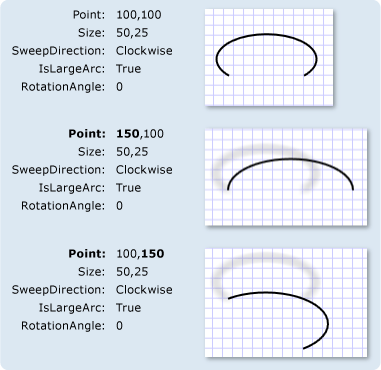
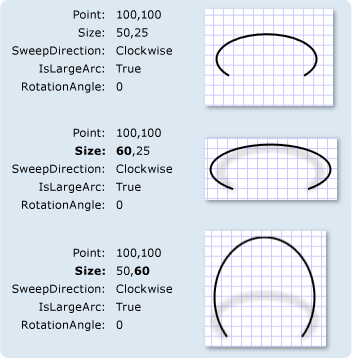
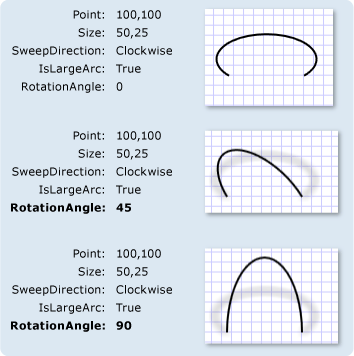
IsLargeArc and SweepDirection
For most arcs of a particular position, size, and rotation, there are four different arcs that can be drawn; the IsLargeArc and SweepDirection properties indicate which arc to use.
Of the four candidate arc sweeps, two represent large arcs with sweeps of 180 degrees or greater, and two represent smaller arcs with sweeps 180 degrees or less. If IsLargeArc is true, then one of the two larger arc sweeps is chosen; otherwise, if is false, one of the smaller arc sweeps is chosen. The remaining two arc candidates are each drawn in a different direction: Counterclockwise or Clockwise. The SweepDirection property specifies which one to use.
The following illustrations show different IsLargeArc and SweepDirection settings.
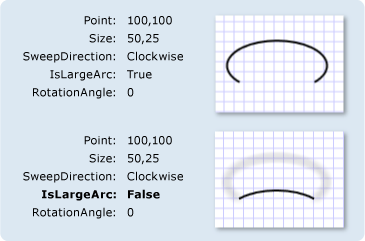 ArcSegment objects with different IsLargeArc settings
ArcSegment objects with different IsLargeArc settings
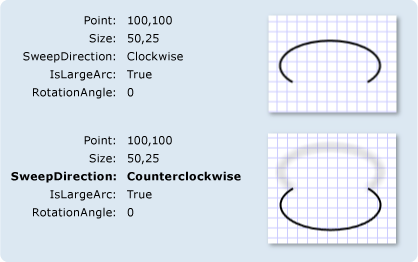 ArcSegment objects with different SweepDirection settings
ArcSegment objects with different SweepDirection settings
Freezable Features
An ArcSegment is a type of Freezable object. For information about Freezable features, such as freezing and cloning, see the Freezable Objects Overview.
Constructors
| ArcSegment() |
Initializes a new instance of the ArcSegment class. |
| ArcSegment(Point, Size, Double, Boolean, SweepDirection, Boolean) |
Initializes a new instance of the ArcSegment class. |
Fields
| IsLargeArcProperty |
Identifies the IsLargeArc dependency property. |
| PointProperty |
Identifies the Point dependency property. |
| RotationAngleProperty |
Identifies the RotationAngle dependency property. |
| SizeProperty |
Identifies the Size dependency property. |
| SweepDirectionProperty |
Identifies the SweepDirection dependency property. |
Properties
| CanFreeze |
Gets a value that indicates whether the object can be made unmodifiable. (Inherited from Freezable) |
| DependencyObjectType |
Gets the DependencyObjectType that wraps the CLR type of this instance. (Inherited from DependencyObject) |
| Dispatcher |
Gets the Dispatcher this DispatcherObject is associated with. (Inherited from DispatcherObject) |
| HasAnimatedProperties |
Gets a value that indicates whether one or more AnimationClock objects is associated with any of this object's dependency properties. (Inherited from Animatable) |
| IsFrozen |
Gets a value that indicates whether the object is currently modifiable. (Inherited from Freezable) |
| IsLargeArc |
Gets or sets a value that indicates whether the arc should be greater than 180 degrees. |
| IsSealed |
Gets a value that indicates whether this instance is currently sealed (read-only). (Inherited from DependencyObject) |
| IsSmoothJoin |
Gets or sets a value that indicates whether the join between this PathSegment and the previous PathSegment is treated as a corner when it is stroked with a Pen. (Inherited from PathSegment) |
| IsStroked |
Gets or sets a value that indicates whether the segment is stroked. (Inherited from PathSegment) |
| Point |
Gets or sets the endpoint of the elliptical arc. |
| RotationAngle |
Gets or sets the amount (in degrees) by which the ellipse is rotated about the x-axis. |
| Size |
Gets or sets the x- and y-radius of the arc as a Size structure. |
| SweepDirection |
Gets or sets a value that specifies whether the arc is drawn in the Clockwise or Counterclockwise direction. |
Methods
| ApplyAnimationClock(DependencyProperty, AnimationClock, HandoffBehavior) |
Applies an AnimationClock to the specified DependencyProperty. If the property is already animated, the specified HandoffBehavior is used. (Inherited from Animatable) |
| ApplyAnimationClock(DependencyProperty, AnimationClock) |
Applies an AnimationClock to the specified DependencyProperty. If the property is already animated, the SnapshotAndReplace handoff behavior is used. (Inherited from Animatable) |
| BeginAnimation(DependencyProperty, AnimationTimeline, HandoffBehavior) |
Applies an animation to the specified DependencyProperty. The animation is started when the next frame is rendered. If the specified property is already animated, the specified HandoffBehavior is used. (Inherited from Animatable) |
| BeginAnimation(DependencyProperty, AnimationTimeline) |
Applies an animation to the specified DependencyProperty. The animation is started when the next frame is rendered. If the specified property is already animated, the SnapshotAndReplace handoff behavior is used. (Inherited from Animatable) |
| CheckAccess() |
Determines whether the calling thread has access to this DispatcherObject. (Inherited from DispatcherObject) |
| ClearValue(DependencyProperty) |
Clears the local value of a property. The property to be cleared is specified by a DependencyProperty identifier. (Inherited from DependencyObject) |
| ClearValue(DependencyPropertyKey) |
Clears the local value of a read-only property. The property to be cleared is specified by a DependencyPropertyKey. (Inherited from DependencyObject) |
| Clone() |
Creates a modifiable clone of this ArcSegment, making deep copies of this object's values. When copying dependency properties, this method copies resource references and data bindings (but they might no longer resolve) but not animations or their current values. |
| CloneCore(Freezable) |
Makes the instance a clone (deep copy) of the specified Freezable using base (non-animated) property values. (Inherited from Freezable) |
| CloneCurrentValue() |
Creates a modifiable clone of this ArcSegment object, making deep copies of this object's current values. Resource references, data bindings, and animations are not copied, but their current values are. |
| CloneCurrentValueCore(Freezable) |
Makes the instance a modifiable clone (deep copy) of the specified Freezable using current property values. (Inherited from Freezable) |
| CoerceValue(DependencyProperty) |
Coerces the value of the specified dependency property. This is accomplished by invoking any CoerceValueCallback function specified in property metadata for the dependency property as it exists on the calling DependencyObject. (Inherited from DependencyObject) |
| CreateInstance() |
Initializes a new instance of the Freezable class. (Inherited from Freezable) |
| CreateInstanceCore() |
When implemented in a derived class, creates a new instance of the Freezable derived class. (Inherited from Freezable) |
| Equals(Object) |
Determines whether a provided DependencyObject is equivalent to the current DependencyObject. (Inherited from DependencyObject) |
| Freeze() |
Makes the current object unmodifiable and sets its IsFrozen property to |
| FreezeCore(Boolean) |
Makes this Animatable object unmodifiable or determines whether it can be made unmodifiable. (Inherited from Animatable) |
| GetAnimationBaseValue(DependencyProperty) |
Returns the non-animated value of the specified DependencyProperty. (Inherited from Animatable) |
| GetAsFrozen() |
Creates a frozen copy of the Freezable, using base (non-animated) property values. Because the copy is frozen, any frozen sub-objects are copied by reference. (Inherited from Freezable) |
| GetAsFrozenCore(Freezable) |
Makes the instance a frozen clone of the specified Freezable using base (non-animated) property values. (Inherited from Freezable) |
| GetCurrentValueAsFrozen() |
Creates a frozen copy of the Freezable using current property values. Because the copy is frozen, any frozen sub-objects are copied by reference. (Inherited from Freezable) |
| GetCurrentValueAsFrozenCore(Freezable) |
Makes the current instance a frozen clone of the specified Freezable. If the object has animated dependency properties, their current animated values are copied. (Inherited from Freezable) |
| GetHashCode() |
Gets a hash code for this DependencyObject. (Inherited from DependencyObject) |
| GetLocalValueEnumerator() |
Creates a specialized enumerator for determining which dependency properties have locally set values on this DependencyObject. (Inherited from DependencyObject) |
| GetType() |
Gets the Type of the current instance. (Inherited from Object) |
| GetValue(DependencyProperty) |
Returns the current effective value of a dependency property on this instance of a DependencyObject. (Inherited from DependencyObject) |
| InvalidateProperty(DependencyProperty) |
Re-evaluates the effective value for the specified dependency property. (Inherited from DependencyObject) |
| MemberwiseClone() |
Creates a shallow copy of the current Object. (Inherited from Object) |
| OnChanged() |
Called when the current Freezable object is modified. (Inherited from Freezable) |
| OnFreezablePropertyChanged(DependencyObject, DependencyObject, DependencyProperty) |
This member supports the Windows Presentation Foundation (WPF) infrastructure and is not intended to be used directly from your code. (Inherited from Freezable) |
| OnFreezablePropertyChanged(DependencyObject, DependencyObject) |
Ensures that appropriate context pointers are established for a DependencyObjectType data member that has just been set. (Inherited from Freezable) |
| OnPropertyChanged(DependencyPropertyChangedEventArgs) |
Overrides the DependencyObject implementation of OnPropertyChanged(DependencyPropertyChangedEventArgs) to also invoke any Changed handlers in response to a changing dependency property of type Freezable. (Inherited from Freezable) |
| ReadLocalValue(DependencyProperty) |
Returns the local value of a dependency property, if it exists. (Inherited from DependencyObject) |
| ReadPreamble() |
Ensures that the Freezable is being accessed from a valid thread. Inheritors of Freezable must call this method at the beginning of any API that reads data members that are not dependency properties. (Inherited from Freezable) |
| SetCurrentValue(DependencyProperty, Object) |
Sets the value of a dependency property without changing its value source. (Inherited from DependencyObject) |
| SetValue(DependencyProperty, Object) |
Sets the local value of a dependency property, specified by its dependency property identifier. (Inherited from DependencyObject) |
| SetValue(DependencyPropertyKey, Object) |
Sets the local value of a read-only dependency property, specified by the DependencyPropertyKey identifier of the dependency property. (Inherited from DependencyObject) |
| ShouldSerializeProperty(DependencyProperty) |
Returns a value that indicates whether serialization processes should serialize the value for the provided dependency property. (Inherited from DependencyObject) |
| ToString() |
Returns a string that represents the current object. (Inherited from Object) |
| VerifyAccess() |
Enforces that the calling thread has access to this DispatcherObject. (Inherited from DispatcherObject) |
| WritePostscript() |
Raises the Changed event for the Freezable and invokes its OnChanged() method. Classes that derive from Freezable should call this method at the end of any API that modifies class members that are not stored as dependency properties. (Inherited from Freezable) |
| WritePreamble() |
Verifies that the Freezable is not frozen and that it is being accessed from a valid threading context. Freezable inheritors should call this method at the beginning of any API that writes to data members that are not dependency properties. (Inherited from Freezable) |
Events
| Changed |
Occurs when the Freezable or an object it contains is modified. (Inherited from Freezable) |
